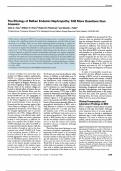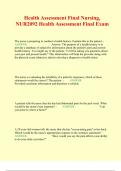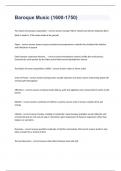Reviews
The Etiology of Balkan Endemic Nephropathy: Still More Questions than
Answers
Calin A. Tatu,1 William H. Orem,2 Robert B. Finkelman,2 and Gerald L. Feder2
1Forslys Group, Timisoara, Romania; 2U.S. Geological Survey, Eastern Energy Resources Team, Reston, VA 20192 USA
existed is available from that period (6). This,
Balkan endemic nephropathy (BEN) has attracted increasing attention as a possible environmen- however, does not preclude the possibility
tal disease, and a significant mount of research from complementary scientific fields has been that the etiological factor(s) responsible for
dedicated to its etiology. There are two actual competing theories attempting to explain the BEN has been present in endemic areas for
cause of this kidney disease: 1) the mycotoxin hypothesis, which considers that BEN is produced centuries or millennia. The increase in the
by ochratoxin A ingested intermittently in small amounts by the indivriduals in the endemic average life expectancy after World War II
regions, and 2) the Pliocene lignite hypothesis, which proposes that the disease is caused by may have allowed BEN to become manifest
long-term exposure to polycyclic aromatic hydrocarbons and other toxic organic compounds and thereafter to be described as a distinct
leaching into the well drinking water from low rank coals underlying or proximal to the enidemic nosological entity. BEN was almost simulta-
settdements. We outline the current developments and future prospects in the study of BEN and neously recognized for the first time in the
differentiate possible factors and cofactors in disease etiology. Key workr. aromatic compounds, three countries involved as well as in each
Balkan endemic nephropathy, chronic interstitial nephropathy, environmental disease, ochatox- major affected region of these countries by
in, Pliocene lignite, urinary tract tumors. Environ Health Perspect 106:689-700 (1998). [Online Tanchev et al. in Bulgaria in 1956 (7), by
9 October 19981 Danilovic and others in 1957 in Yugoslavia
htp:/ellehpnetl. niehs. nih.gov/docs/1998/1106p689-700tat1abstract.html (8), and by Fortza and Negoescu in Romania
in 1961 (5.
In spite of considerable research per-
A matter of debate for more than four 30-50 years are most heavily affected, while formed in the three afflicted countries, the
decades (1), Balkan endemic nephropathy almost no children or individuals over 70 etiology of BEN and of its accompanying
(BEN) is a chronic tubulointerstitial years of age develop the disease); 5) a slight uroepithelial tumors still remains a medical
nephropathy (CIN) described so far in sev- sex distribution, with a female:male sex enigma. Multidisciplinary studies involving
eral rural regions of Bulgaria, Romania, and ratio of about 1.5:1; 6) a similar incidence environmental and occupational medicine,
the former Yugoslavia (Serbia, Croatia, and in different ethnic and religious groups; microbiology, oncology, toxicology, epi-
Bosnia). Most of the endemic villages are and 7) restriction to a rural farming popu- demiology, cytogenetics, and more recently,
located on alluvial valleys of streams that are lation. Of particular interest are the upper geology, hydrogeology, and biogeochem-
tributaries of the Danube River, and the urinary tract tumors (UTTs) seen in BEN istry have added some pieces to the puzzle,
area where the disease occurs does not patients at frequencies much higher than in but have also raised new questions (10).
exceed 20,000 km2 (2). The topography of individuals not suffering from BEN from Among these, the most central remains:
the disease sites varies from the flood plains endemic regions or in the general popula- What is the true cause of the disease?
in the former Yugoslavia to the undulating tion in the countries with BEN. The distri-
hills around Drobeta Turnu Severin in bution of these tumors generally follows the Clinical Presentation and
Romania and the low montane region of the geographical distribution of BEN, with a Laboratory Findings in BEN
Vratza District in Bulgaria (3) (Fig. 1). The steep decrease in incidence in nonendemic BEN is a progressive kidney disease inexorably
geographical distribution of the disease has villages located even 1-2 miles away from leading to end stage renal failure. Although
not changed significantly since it was first the endemic ones. UTTs are frequently some symptoms seem to be more specific,
described in the 1950s. Villages afflicted in multiple and bilateral and rarely occur in there is no clear-cut clinical or pathological
the past continue to be afflicted today, while the general population. Their high inci- definition that is solely sufficient for disease
nonendemic villages and towns, sometimes dence in BEN patients led to speculation diagnosis. The onset is without any acute
located in close proximity to afflicted vil- that the two diseases could be causally relat- episode, and the anecdotal cases of acute BEN
lages, have remained free of BEN. At least ed (1) or that the urinary tract tumors described in the literature seem to be related
25,000 individuals may suffer from BEN or should be seen as a symptom, although
are suspected of having the disease, while the inconstant, of BEN.
total number of people at risk in the three There have been several attempts to trace Address correspondence to C. Tatu, Department of
countries may exceed 100,000 (4,5). Some the history of endemic nephropathy to the Microbiology and Immunology, University of
North Carolina at Chapel Hill, CB#7290 804
of the intriguing features of BEN are 1) beginnings of this century or to the period MEJB, Chapel Hill, NC 27599-7290 USA.
focal occurrence of the clinical cases; 2) between the two world wars. Because BEN Support for W.H. Orem was provided by the
familial aggregation without an obvious pat- becomes manifest at older ages and the aver- Energy Resources Program, U.S. Geological Survey.
tern of Mendelian genetic inheritance; 3) age life expectancy in the endemic settle- We are grateful to John Kellen (University of
long "incubation" period before the clinical ments was less than 45-50 years before Toronto, Canada) and Tudor Oprea (Astra AB,
onset of the disease (people coming from World War II (some of the major causes of Sweden) for insightful discussions, and to Virgil
Paunescu (Ministry of Health, Bucharest, Romania)
outside must reside in the endemic region earlier death were parasitic or infectious dis- for providing us unpublished data related to Balkan
for more than 10-15 years to acquire the eases such as malaria and tuberculosis), no endemic nephropathy.
disease); 4) occurrence only in adults (ages rigorous description of the disease or clue it Received 29 April 1998; accepted 10 July 1998.
Environmental Health Perspectives * Volume 106, Number 1 1, November 1998 689
, Reviews * Tatu et al.
to kidney diseases other than BEN (or going (reduced tubular transport, intermittent pro- the early impairment of the juxtaglomerular
along with BEN) that may occur in the teinuria with low molecular weight proteins apparatus. Anemia (normocytic, nor-
endemic regions. The disease progresses slow- such as [-2 microglobulin, and a gradual rise mochromic, or in rare cases, hypochromic or
ly with the occurrence of nonspecific signs in blood nitrogen) (11). Usually, no increased even aplastic) is one of the major symptoms,
(lassitude, fatigue, headache, weight loss and blood pressure is found, even in the more and it seems to develop well before other
reduced appetite, xanthochromic or pale advanced phases of the disease; this was signs of BEN become manifest. Although in
skin) and specific signs of kidney damage explained by Dammin (12) as the outcome of the advanced stages of the disease anemia is
Figure 1. Map showing the distribution of the Balkan endemic nephropathy (BEN) areas in the Balkan Peninsula. Adapted from Feder et al. (29) and the CIA World
Factbook 1984 (63).
690 Volume 106, Number 1 1, November 1998 * Environmental Health Perspectives






